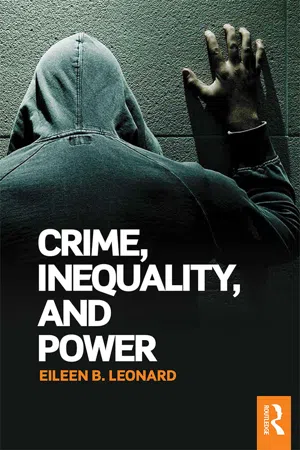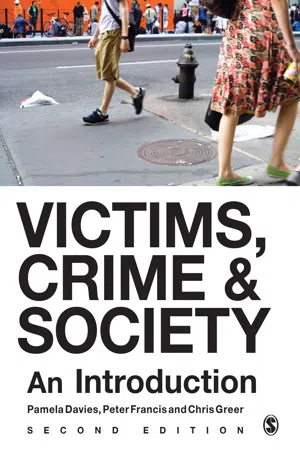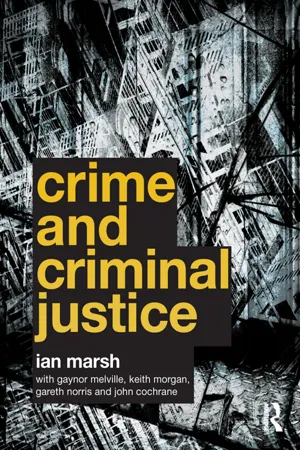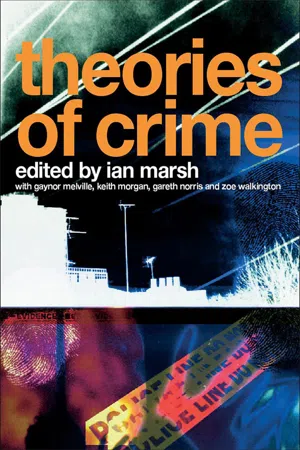Social Sciences
Social Class and Crime
Social class and crime refers to the relationship between an individual's socioeconomic status and their likelihood of engaging in criminal behavior. Research suggests that individuals from lower social classes are more likely to be involved in criminal activities due to factors such as limited opportunities, economic strain, and exposure to criminogenic environments. This connection between social class and crime is a key focus in criminology and sociology.
Written by Perlego with AI-assistance
Related key terms
5 Key excerpts on "Social Class and Crime"
- eBook - ePub
- Eileen B. Leonard(Author)
- 2015(Publication Date)
- Routledge(Publisher)
1 The Social Construction of Crime DOI: 10.4324/9781315743790-1We have noted the emphasis placed on street crime and the value of a comparative perspective in demonstrating the stereotypical ways we view crime and criminals. Our purpose, however, is not only to challenge “common sense” understandings of crime but also to examine how these understandings are related to entrenched patterns of inequality in American society. In light of this, it may be useful to briefly review how sociologists think about crime and social categories such as class, race, and gender. It is not my purpose to provide a detailed discussion of the many concepts and theoretical perspectives that have been used to analyze crime, but instead to point to a few that have informed this text, raising central questions and providing frameworks that should be of use to any student of crime.A Sociological Perspective
One of the basic principles of sociology is that we are profoundly affected not just by our immediate personal situation but also by the larger social system. It follows that to make sense of our lives, and our society, we need to understand this larger social context and the influence it exerts on us, including how wealth and power are distributed, as well as the force of our cultural beliefs and practices. This provides a fuller understanding of the social world and enables us to be more knowing participants in it. Sociology is not only an intellectual discipline. Understanding larger social issues, where they come from, and how they relate to us offers the possibility of being part of the solution to these issues as well (Johnson, 2008 : 152).One of the impediments to this type of analysis lies in the U.S. emphasis on individualism. Americans are steeped in a way of thinking that encourages us to explain the world in terms of what goes on inside individuals and nothing else. The presentation of crime, for example, is often framed as a problem of “bad people.” But thinking about it in such individualistic terms is fragmentary and dangerous because it prevents us from seeing the larger social context and the systemic issues involved. Broader social forces that would provide context, and a deeper understanding of a variety of crimes, are largely shunned. The question becomes: What’s wrong with “these people”? It logically follows that individuals need to be changed, not the social conditions that actually foster crime. Thus policy alternatives involving structural and organizational change are largely absent (Henry, 2003 - eBook - ePub
Victims, Crime and Society
An Introduction
- Pamela Davies, Peter Francis, Chris Greer(Authors)
- 2017(Publication Date)
- SAGE Publications Ltd(Publisher)
Chapter 13 in this volume. It will be noted that in the title and elsewhere the terms ‘socio-economic inequalities’ and ‘socio-economic status’ are used in preference to terms such as ‘lower class’, ‘social class’ or ‘social exclusion’, all widely used to express the unequal impact of crime. This is largely because the term ‘socio-economic’ can encompass the different and interrelated dimensions of social inequality often used in surveys such as income, area of residence or economic activity (Croall, 2011). They also avoid the more pejorative and subjective ways in which terms such as ‘social exclusion’ or the ‘underclass’ have been used. Nonetheless, to avoid tedious repetition, the chapter will refer to contrasts, for example between the ‘affluent’ and the ‘poor’.Background: Conceptualising Socio-Economic Inequality, Crime and Victimisation
Positivist victimology and quantitative victim surveys tend to focus on the individual characteristics of victims rather than socio-economic or structural factors. This has been widely criticised. The left-realist approach, for example, challenged the impression given by earlier versions of the British Crime Survey (BCS) that there was a low average risk for burglary as this concealed higher risks in poorer areas. Although in turn criticised for their reliance on quantitative victim surveys, they did call for more studies of the ‘lived reality’ of crime, particularly amongst the poor, and did raise important questions about the wider socio-economic framework of victimisation (Davies et al., 2003; Walklate, 2003).Critical victimology also asks many relevant questions in relation to economic inequality (Walklate, 2003; Mawby and Walklate, 1994). It asks us to look ‘behind our backs’ and to reflect on victimisation which we ‘do not see’ and argues that the processes of victimisation are socially, economically and culturally situated, thus relating victimisation to broader questions of social structure and power and exploring the interconnected links between social class, gender, race and crime (Davies et al., 2007). Walklate also criticises the dualism between victims and offenders by recognising that they are more often drawn from the same social groups. Offending and victimisation are seen as part of a process rather than as single events involving individual offenders and victims. These points are all highly relevant to the exploration of socio-economic status and victimisation. - eBook - ePub
- Ian Marsh, Gaynor Melville, Keith Morgan, Gareth Norris, John Cochrane(Authors)
- 2011(Publication Date)
- Routledge(Publisher)
This emphasis on interactions indicates the influence of the notion of differential association on the labelling explanations that developed from the interactionist (sometimes known as symbolic interactionist) perspective within sociology. The major interactionist theorists were influenced by the Edwin Sutherland, the social psychologist George Herbert Mead and others from the ‘Chicago School’. They focused on the key role of meanings in social life and the socially constructed nature of reality – they paid particular attention to the ways that individuals create their world, rather than being just products of it. Social reality, from this approach, is constructed through the interpretation of the meaning of actions (interactions).Interactionist Theories
Partly in response to some of the problems associated with the structural and subcultural theories, a different theoretical approach was developed by the interactionist perspective that became particularly influential in sociology in the 1960s and 1970s. Rather than seeing crime and deviant behaviour as a response of people to their social situation – and a response which established them as distinct from the mainstream, ‘normal’ population – the interactionist position was that the criminal or deviant can be quite normal. The emphasis, therefore, should be on how society defines certain individuals and groups as criminal or deviant; and the social reaction such individuals and groups engender. As can be seen from this introductory paragraph, interactionists refer to both crime and deviance, and the terms are quite often used interchangeably. Essentially, crime can be defined as action that breaks the criminal law and can be followed by criminal proceedings, while deviance is not used in its literal sense (as anything that is different or deviates from the normal) but taken to refer to any behaviour that is outside the rules of society and that is generally disapproved of. These rules might be legal rules, such as laws, or social and moral rules, such as conventional rules about how people should behave in public, for instance. Below we will usually refer to crime and criminal behaviour when introducing labelling theory.A major criticism of the earlier theories of crime, from both outside of and within sociology, was their tendency to see such behaviour as relatively straightforward and easily recognizable – as behaviour that breaks the law. Such approaches imply that a general consensus exists within society as to what is right and wrong behaviour. Interactionist work questions this assumption. Numerous studies, plus our commonsense understanding, tell us that most people have broken the law, and that many people do so frequently without ever being recorded as criminals. Given this, it becomes difficult to argue that criminals are somehow different from the rest of society. - eBook - ePub
- Sandra Walklate(Author)
- 2016(Publication Date)
- Routledge(Publisher)
Much of the discussion above has drawn implicitly on an understanding of crime and the problem of crime that might be best understood as being the ‘criminality of the state’. This view of crime and criminology relies, in different ways, on the work of Karl Marx. Marx drew attention to the way in which the powerful in society use the range of resources available to them, including the law, to secure and maintain their dominant position. In this view of society, the law and the processes that underpin the law and its practice are at the centre of critical scrutiny. Such scrutiny puts to the fore the way in which some groups in society are targeted by the law and its practice and others are not. Put simply, the law and its enforcement become arenas in which the powers of the state are made legitimate. For a criminologist working within this kind of framework, these powers express themselves especially along class, race and gender lines. Hence, the rich get richer and the poor get prison. This way of thinking about the nature of crime and criminal victimisation is an important dimension to criminology, though it takes a variety of forms and we shall discuss three of them briefly here: Marxist criminology, radical criminology and critical criminology.MARXIST CRIMINOLOGY
Marx himself had little to say about crime or the law, but the general tenor of his views can be translated into the context of criminology. Two important writers who have done this are both North American, Chambliss (1975) and Quinney (1977). Chambliss argued that capitalism creates the desire to consume and since not all members of society are able to earn enough to match the levels of consumption generated by capitalism, this puts the haves and the have nots in conflict with one another. This view does not presume therefore that only the have nots (the poor) will engage in criminal behaviour, but it does presume that it is their behaviour that will be the focus of the criminal law. He says:Criminality is simply not something that people have or don’t have; crime is not something some people do and others don’t. Crime is a matter of who can pin the label on whom, and underlying this socio-political process is the structure of social relations determined by the political economy.(Chambliss, 1975 cited in Muncie et al. 1996: 228)So for Chambliss the underlying cause of crime (remember criminology, as was outlined in Chapter 1 - eBook - ePub
- Ian Marsh(Author)
- 2007(Publication Date)
- Routledge(Publisher)
Sutherland argued that crime was socially defined by powerful sections of society, but he did not lose sight of the individual and how particular individuals were drawn into crime. He felt that criminal behaviour was learned just as any form of behaviour is. This led to the question of how is criminal behaviour learned, which Sutherland answered in terms of differential association: individuals have differential associations with other people who are either more or less disposed to criminality. The essence of this approach is that criminal behaviour is learned; the learning occurs through association with other people; learning includes ways and means for carrying out crimes; and so the process involved in learning criminal behaviour is no different from that involved in learning any other type of behaviour. It can be seen from this brief account that Sutherland’s theory is both sociological, in its acknowledgement of the powerful of social forces to define crime, and psychological, with its concern for the individual. And, as with Matza’s work, Sutherland applied his theory of differential association to business crime or crimes of the powerful.This emphasis on interactions indicates the influence of the notion of differential association on the labelling explanations that developed from the interactionist (sometimes known as symbolic interactionist) perspective within sociology.INTERACTIONIST THEORIES
Partly in response to some of the problems associated with the structural and subcultural theories, a different theoretical approach was developed by the interactionist perspective that became particularly influential in sociology in the 1960s and 1970s. Rather than seeing crime and deviant behaviour as a response of people to their social situation—and a response which established them as distinct from the mainstream, ‘normal’ population—the interactionist position was that the criminal or deviant can be quite normal. The emphasis, therefore, should be on how society defines certain individuals and groups as criminal or deviant. As can be seen from this introductory paragraph, interactionists refer to both crime and deviance, and the terms are quite often used interchangeably. Essentially, crime can be defined as action that breaks the criminal law and can be followed by criminal proceedings, while deviance is not used in its literal sense (as anything that is different or deviates from the normal) but taken to refer to any behaviour that is outside the rules of society and that is generally disapproved of. These rules might be legal rules, such as laws, or social and moral rules, such as conventional rules about how people should behave in public, for instance. Below we will usually refer to crime and criminal behaviour when introducing labelling theory.
Learn about this page
Index pages curate the most relevant extracts from our library of academic textbooks. They’ve been created using an in-house natural language model (NLM), each adding context and meaning to key research topics.




